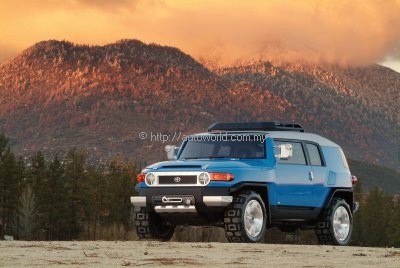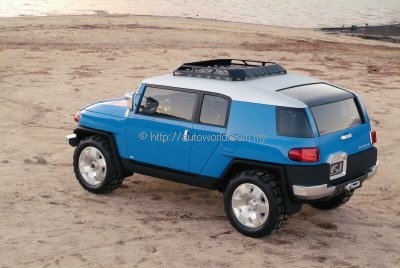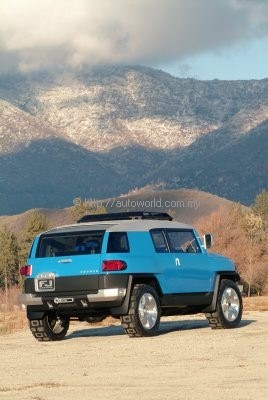Toyota FJ Cruiser Concept
The FJ Cruiser concept was initiated and developed jointly by Toyota USA and Calty Design Research, Toyota’s North American design centre in California. Developed as a basic, capable and affordable off-roader aimed to explore new possibilities for a next-generation SUV, it is aimed specifically at young buyers with active outdoor lifestyles.
The FJ Cruiser is a thoroughly modern concept vehicle chiseled from nearly a half-century tradition of rugged performance provided by the legendary FJ 40 Land Cruiser, the original 4Runner and 4×4 compact pickups. It effectively connects two growing markets in the USA – the light truck segment and the emerging youth market.
 |
“The FJ Cruiser takes on an authentic functional form, yet adopts several styling cues from the original FJ,” said Jin Kim, the FJ Cruiser’s 25-year-old exterior designer. “Some of these cues are notable on the front end by its wide and narrow grille, round headlights, and offset combination lamps. Additional inspiration can be found through its upright windshield and two-tone cap roof. Traits are also noticeable in the rear with wrapping rear corner windows. The modern shape of the FJ Cruiser is woven into a compact package. Its proportionately long wheelbase and wide track produce enhanced stability and a powerful stance.”
Utility features include spotlights on both outside mirrors, an asymmetrical front spotlight, and a front-end towing winch. The rear glass panel is a two-piece unit that retracts into the roof and the rear hatch for easy access to the rear cargo area. Easy rear passenger entry into the two-door SUV is achieved with rear access doors.
Power is supplied by a 3.4-litre V6 engine equipped with a Toyota Racing Development (TRD) supercharger that creates 184 kW/250 bhp. The engine is paired with a 4-speed automatic transmission and 4WD with a low range. The FJ Cruiser rides on a modified Tacoma pickup platform and is equipped with rear coil-over long travel suspension, 20-inch wheels and 33-inch tyres, and a TRD cat-back exhaust.
Calty designer William Chergosky extended the rugged and straightforward theme to the interior. “The cabin is designed specifically for basic functionality and flexible utility,” said Chergosky. “The structural beam instrument panel has a sophisticated, handcrafted appearance. The faceplate with round inset instrumentation communicates precision and ruggedness. The steering wheel and centre-mounted shifter, and attached look door panels feature tool-like simplicity with an industrial feel. A portable remote GPS is removable for wilderness hiking.”
All front and rear seats fold completely flat creating ample cargo space and maximum usability. With no gaps and a durable floor covering, the FJ Cruiser can be converted into a utility deck large enough for two people in their sleeping bags.
In conceiving the FJ Cruiser, the designers feel it is a thoughtful approach to versatility that allows the customer to decide how the vehicle fits into their active lifestyles.
TOYOTA FJ CRUISER DIMENSIONS
Wheelbase : 2700 mm
Overall Length : 4340 mm
Overall Height : 1828 mm
Overall Width : 1920 mm





























